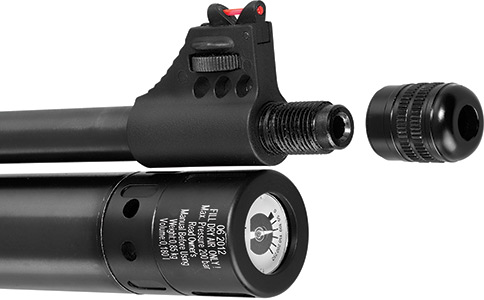AT44-10
1070fps POWER!
- 10- shot, manual loading, side lever action, pre-charged pneumatic
- (PCP) air rifle.
- Precision rifled choked barrel for accuracy, threaded for ½” UNF sound moderator & fitted muzzle cap.
- Available in .177 (4.5mm), .22 (5.5mm) and .25 (6.35mm) caliber.
- Thumbhole synthetic ambidextrous stock.
- Elavation adjustable comb which can be easily adjusted by a coin
- Integrated picatinny rail beneatch the forearm
- Elevation & fit angle adjustable rubber butt pad.
- Detachable 10-shot rotary magazine in .177 (4.5mm) and .22 (5.5mm) calibers and 9-shot rotary magazine in 25 (6.35mm) caliber.
- Includes one additional magazine.
- Detachable steel air cylinder tube (180cc). Spare cylinders are available.
- Built-in pressure gauge on the air cylinder to monitor the cylinder pressure.
- Includes quick-fill nozzle & air cylinder discharging cap supplied in the box.
- Dovetail groove receiver for both 11mm and 22mm scope mounts.
- Overall blued finish, black anodized receiver.
- Manual & Automatic Safety
- “Anti-double pellet feed” mechanism preventing more than one pellet loading into barrel.
- Patented anti-knock system to prevent gas wastage when rifle is knocked or bounced.
- Adjustable rear & front sight with Truglo fiber optics.
- Quattro Trigger: 2-stage full adjustable match trigger for trigger travel and trigger load.
- Gold plated metal trigger & metal trigger guard.
- Fitted sling swivels
- Long version (AT44-10 Long) available with 230cc air cylinder tube, 58cm barrel and 100fps (30m/s) more muzzle velocity.
* Above maximum muzzle velocity figures may differ depending on the pellet weight & shape.
* The energy restriction of a particular country can be achieved by the reduction in the muzzle velocity. The above maximum velocity figures are obtained when there is no energy restriction on the air rifle and when measured at optimum pressure value in the air tube. As a nature of PCP air rifles the velocity starts low at maximum pressure level in the air tube, then starts to increase and gets to the maximum at optimum pressure value in the air tube; and then it starts to decrease again as the pressure in the air cylinder gets too low.





AT44X-10
Fixed sound moderator equipped version with no sights.
Hatsan recommends Optima 3-12x44AOE scope with AT44X-10.
Available in Camo and MW finish versions.
AT44-10 CAMO![]()
Mossy Oak Break-Up camo version.
AT44-10 MW
Luxurious walnut woodgrain camo version.
AT44-10 Long
Long version with 230cc air cylinder tube, 58cm barrel and 100fps (30m/s)
more muzzle velocity. Available in Camo and MW finish versions.

- Manual & Auto Safety.
- Scope mount rail for both 11 mm and 22 mm scope mounts.
- 10-shot magazine (9-shot magazine in .25 /6.35mm caliber)
- Micro adjustable rear sight.
- Quattro Trigger: 2-stage full adjustable match trigger for trigger travel and trigger load.
- Gold plated trigger blade

Elavation adjustable comb which can be easily adjusted by a coin.
Elevation & fit angle adjustable rubber butt pad.

½” UNF threaded muzzle and fitted muzzle cap.
Detachable 180cc air cylinder for 200 bar fill pressure with built in pressure gauge. (230cc air cylinder in long version).
Adjustable front sight

AT44 & AT44-10 SERIES
PCP AIR RIFLE
Instruction Manual GB
Manual de Instrucciones ES
Kullanma Kılavuzu TR
Руководство Пользователя
1
2
3
Product Manual
<
>
Features


